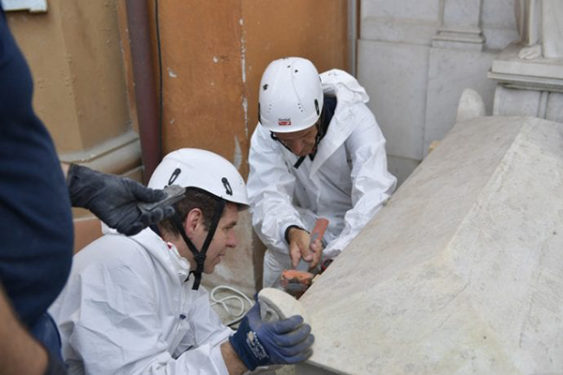
By John L. Allen
ROME – Christianity, of course, is founded on the discovery of an empty tomb. Perhaps it’s only fitting, therefore, that Christ’s vicar on earth now has his own “empty tomb” ferment on his hands.
This one, however, almost certainly isn’t a prelude to resurrection, but rather to yet another of what the Italians call a giallo, meaning a mystery story that acts as a magnet for speculation and conspiracy theories.
This Thursday, technicians opened a tomb in a German cemetery on Vatican grounds known as the Campo Teutonico in an effort to locate the remains of Emanuela Orlandi, a 15-year-old girl and daughter of a Vatican employee when she disappeared in 1983, whose fate has been the most enduring giallo in Italian life over the last 35 years. The opening occurred in the presence of members of Orlandi’s family and legal team, the head of the Vatican Gendarmes, and descendants of the supposed occupants of the tombs.
A decision by a Vatican magistrate to authorize the opening came following an anonymous letter sent to the Orlandi family advising them to check the spot, marked by a statue of an angel, which was supposed to be the resting place of two 19th century princesses: Sophie von Hohenlohe, who died in 1836, and Carlotta Federica of Mecklenburg, who died in 1840.
Some Italian observers also were hoping to find a clue as to the whereabouts of Mirella Gregori, another teenage girl who vanished 40 days before Orlandi, and whose mother once identified a Vatican security official as the man who used to visit her daughter shortly before her disappearance.
Upon opening the tomb and entering it, however, it was found completely empty – no Orlandi or Gregori, and no princesses either.
“They went down and found a room measuring 4 meters by 3 meters (13 feet by 10 feet), which was the first surprise …There was absolutely nothing inside,” Emanuela’s brother, Pietro Orlandi, told reporters.
Vatican officials said the most likely explanation is that the remains of the two princesses were moved during work performed in the cemetery either in the late 19th century or in the 1950s and ’60s, and, for whatever reason, never returned. Presumably, an official said, there’s a record someplace of what happened and where the remains are stored.
On Saturday, the Vatican announced that it had discovered two ossuaries under a floor in the Campo Teutonico apparently placed there during the work in the 1960s, and that they had immediately been sealed. Testing on the remains will take place, according to the announcement, next Saturday in the presence of representatives of the Orlandi family and the Gendarmes.
Relatives of the princesses predictably expressed astonishment.
Actress and fashion designer Ira von Fürstenberg, a distant relation to von Hohenlohe by marriage – who, for the record, said she was reached by a reporter at the beauty parlor – called the situation “incredible” and “crazy.” (At the moment, she’s out promoting her new book from HarperCollins, titled Ira: The Life and Times of a Princess.)
“Obviously, they cleaned it out before the inspection,” my friend confidently declared, referring to unknown Vatican agents. “Whatever was in there was worse than Orlandi … it was something they couldn’t afford to let anyone see.”
Bear in mind, this guy, who’s probably in his forties, has grown up around the Vatican his entire life and can name heads of Vatican departments the way many Italians can identify professional soccer players. He’s therefore a classic case of familiarity breeding, if not exactly contempt, at least deep suspicion.
Granted, such speculation is loads of fun – there’s a reason, after all, that it’s basically Italy’s favorite indoor sport. Yet in all honesty, anyone who’s spent much time in the place tends to dismiss most such rumors, and for a simple reason: They give Vatican personnel far too much credit.
Most Vatican personnel aren’t cunning criminal masterminds from a James Bond movie, and sustaining a highly intricate conspiracy is, frankly, almost always beyond their mettle. That’s not to say some Vatican types don’t occasionally get together to do nefarious or scandalous things, just that typically they’re not that adept at keeping them hidden. (If there were some deep, dark secret about the tomb, we’d probably already be reading about it in a new volume by renowned Italian leak-master Gianluigi Nuzzi.)
The fact that most Vatican conspiracy theories are fantasies, however, doesn’t mean they shouldn’t give officials pause.
As long as people believe the Vatican has something to hide when it comes to two 19th century princesses, or a vanished girl, it’s that much harder to believe “All the Pope’s Men” about something serious – for instance, the clerical sexual abuse crisis and Pope Francis’s ongoing efforts to promote reform.
As a result, Pope Francis and his team might be well advised to get to the bottom of what happened to the missing royal remains as quickly as possible, and to make the findings, whatever they may be, public swiftly. Next Saturday’s tests seem a good step in that direction.
If the perception becomes fixed that the Vatican is sweeping something under the rug on the empty tomb, imagine what the reaction will be when they ask the public to trust them on something that really matters – for instance, a report said to be forthcoming on who knew what, and when, about ex-cardinal and ex-priest Theodore McCarrick.
